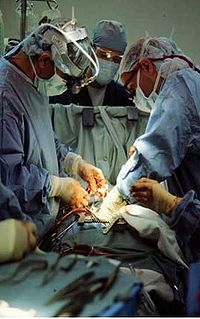
Photo from wikipedia
Peri-operative atrial fibrillation and flutter (POAF) is recognized as a common complication of non-cardiac thoracic surgery. It is associated with hemodynamic instability, prolonged hospital stay, a risk of stroke and… Click to show full abstract
Peri-operative atrial fibrillation and flutter (POAF) is recognized as a common complication of non-cardiac thoracic surgery. It is associated with hemodynamic instability, prolonged hospital stay, a risk of stroke and increased risk of mortality. The potential pathogenesis for POAF after non-cardiac thoracic surgery is multifactorial and not fully understood yet. Evaluation of risk factors and prediction of POAF can be beneficial for prevention and management of POAF in patients undergoing non-cardiac thoracic surgery. In this article, we reviewed related studies in order to provide a practically and clinically applicable strategy for anesthesiologists to effectively predict, prevent and manage new onset POAF in patients undergoing non-cardiac thoracic surgery.
Journal Title: Minerva anestesiologica
Year Published: 2022
Link to full text (if available)
Share on Social Media: Sign Up to like & get
recommendations!